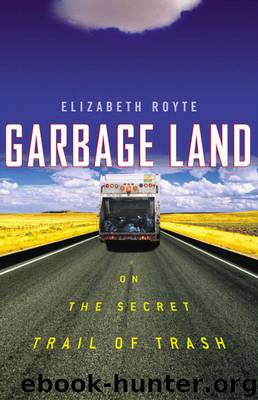Garbage Land: On the Secret Trail of Trash by Elizabeth Royte

Author:Elizabeth Royte [ROYTE, ELIZABETH]
Language: eng
Format: epub
Tags: General, Political Science, Social Science, Sociology, Public Policy, Environmental Policy, POL044000, Rural
ISBN: 9780316030731
Publisher: Back Bay Books
Published: 2007-10-15T00:00:00+00:00
Driving home, I realized that I hadn’t seen any tuna cans in the Claremont yard. I called Shinn, and he assured me they were there. Some of them were surely mine. Every Wednesday morning at about 7:00 a.m., a packer truck from the Brooklyn South 6 garage grunted and hissed up my street. Usually it was James Sheehan and Dominick Basso on truck CN210. One of them drove while the other stepped off the back and quickly tipped my building’s plastic barrel, which was a quarter filled with metal cans, into the hopper. (When glass and plastic recycling returned, in two years, our fifty-gallon barrel would, each week, be full, and thirty pounds heavier.) Sheehan and Basso switched every few blocks. The work seemed especially monotonous, if not particularly strenuous. No brownstone’s metal-recycling bin weighed more than a few pounds.
“It’s a lot of work,” Sheehan said to me one day. “The route is an entire section now.”
“How long is that?” I asked. Sheehan gave me the san man’s salute, a two-shouldered shrug. (There was another salute, a more Seinfeldian movement in which the right hand was raised and then flipped downward in a “fuggedaboutit” gesture. You’d use it, for example, in a mongo situation. “You want this VCR?” Hand gesture: “Take it! I got one a-reddy!”) Without plastic and glass in the recycling bins, the guys on metal could go for eight hours and never pack out. The next shift took the same truck, and when it held four or five tons—after two or three days—it was relayed to the Hugo Neu scrap yard in Long Island City, in Queens.
There, just as in Jersey City, a grapple would drop my tuna can onto the conveyor belt, and the can would dive into the whirring Prolerizer, then fall onto a pan and then onto another conveyor belt, which would send it past the pickers, who would ignore it. The can would drop down to recombine with another stream, travel up a stacking conveyor, and plink down on a pile of shredded scrap. When the pile got big enough, it would be barged to Jersey City and loaded onto a ship, along with shredded cars and washing machines, bound for Asia.
I didn’t buy soda, and if I did I’d surely redeem my aluminum cans for nickels, much to the Neus’ dismay. Nationwide, beer and soda cans are the most-recycled consumer product. But their rate of return fell from a peak of 65 percent in 1992 to a twenty-three-year low of 44 percent in 2003, when 820,000 tons of aluminum cans were trashed. The Container Recycling Institute estimates that more than a trillion aluminum cans have been buried in landfills since 1972, when industry started keeping records. The amount is nearly equal in weight to the world’s entire annual output of primary aluminum ingot. If all those cans were dug up, according to the Institute’s Jenny Gitlitz, they’d have a value of $21 billion at today’s scrap prices. The entombed cans have raised the issue of landfill mining, which might become common practice as natural resources disappear.
Download
This site does not store any files on its server. We only index and link to content provided by other sites. Please contact the content providers to delete copyright contents if any and email us, we'll remove relevant links or contents immediately.
| Anthropology | Archaeology |
| Philosophy | Politics & Government |
| Social Sciences | Sociology |
| Women's Studies |
Nudge - Improving Decisions about Health, Wealth, and Happiness by Thaler Sunstein(7662)
iGen by Jean M. Twenge(5387)
The Fire Next Time by James Baldwin(5386)
Adulting by Kelly Williams Brown(4536)
The Sports Rules Book by Human Kinetics(4348)
The Hacking of the American Mind by Robert H. Lustig(4342)
The Ethical Slut by Janet W. Hardy(4218)
Captivate by Vanessa Van Edwards(3818)
Mummy Knew by Lisa James(3659)
In a Sunburned Country by Bill Bryson(3509)
The Worm at the Core by Sheldon Solomon(3457)
Ants Among Elephants by Sujatha Gidla(3442)
The 48 laws of power by Robert Greene & Joost Elffers(3150)
Suicide: A Study in Sociology by Emile Durkheim(2990)
The Slow Fix: Solve Problems, Work Smarter, and Live Better In a World Addicted to Speed by Carl Honore(2979)
The Tipping Point by Malcolm Gladwell(2874)
Humans of New York by Brandon Stanton(2848)
Handbook of Forensic Sociology and Psychology by Stephen J. Morewitz & Mark L. Goldstein(2679)
The Happy Hooker by Xaviera Hollander(2673)
